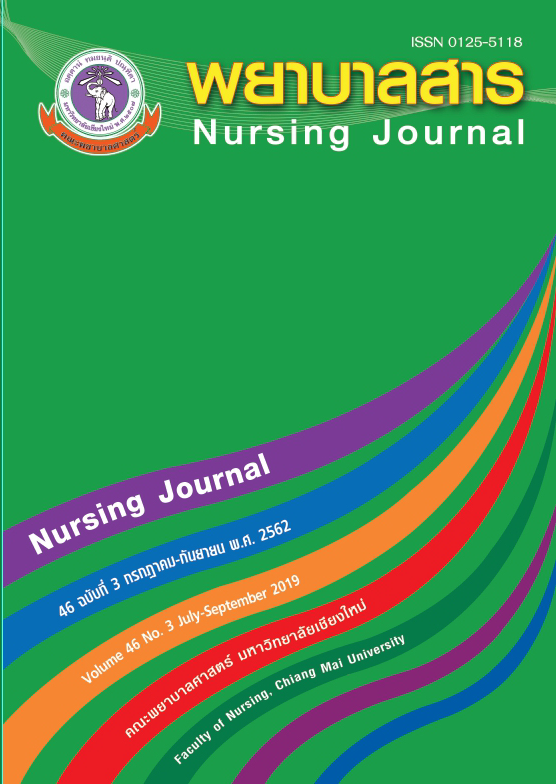Development and Testing of the Emergency Department Nurses’ Capacity Enhancing Program on Pain Management
Keywords:
The Emergency Department Nurses’ Capacity Enhancing Program on Pain Management, Pain Relief, Pain Relief, Satisfaction towards Pain ManagementAbstract
Pain has a major impact on a person’s physical, psychological, and emotional well-being. It is also a common cause of those seeking services at emergency departments. Efficient pain management is a crucial responsibility among emergency department nurses. This developmental research, based on the PRECEDE - PROCEED model of Green and Kreuter (2005), aimed to develop and test effects of the emergency department nurses’ capacity enhancing program on pain management. Research outcomes were measured by the number of clients who expressed “moderate” or higher pain relief, and the number of clients who expressed “satisfaction” or higher towards pain management.
Participants recruited for this study were 33 emergency department registered nurses working at Maharaj Nakorn Chiang Mai Hospital, and 600 clients who sought services at the emergency department, also at Maharaj Nakorn Chiang Mai Hospital. The latter group of clients were divided equally into 2 groups of 300; the group of clients before the program implementation and the group of clients after the program implementation. Duration of study was September to December, 2013.
Data collection instruments were the clients’ demographic record form, the Pain Relief Questionnaire, and the Satisfaction Toward Emergency Department Pain Management Questionnaire. Study outcomes from between, before, and after the program implementation were analyzed using descriptive statistics and chi square–tests.
The results of this study revealed that:
- The emergency department nurses’capacity enhancing program on pain management was effective and consisted of 1) Predisposing factor management including the management of nurses’ knowledge, attitude and skill; 2)Reinforcing factors management including motivation enhancement, rewarding, providing feedback, and pain management monitoring; and 3) Enabling factor management for pain management in the emergency department, including supportive environment enhancement;
- After program implementation, the number of clients who expressed “moderate” or higher pain relief was higher than the number before the program implementation (p < .01); and
- After program implementation, the number of clients who expressed “satisfaction” towards pain management or higher was higher than of the number before the program implementation (p < .001).
The findings of this study demonstrate that the implementation of the emergency department nurses’ capacity enhancing program on pain management, based on the PRECEDE - PROCEED model, is efficient in supporting the department’s pain management system. Therefore, it should be continuously implemented in emergency departments to ensure an efficient and sustainable pain management system.
References
de Round, M. E. J., de Wit, R., van Dam, F.S.A.M., & Muller, M. J. (2000).A pain monitoring program for nurses: effect on the administration of analgesics. Pain, 89, 25-38
Duignan, M., & Dunn, V. (2008). Congruence of pain assessment between nurses and emergency department patients: A replication. International emergency nursing, 16, 23-28.
Fosnocht, D. E., Heaps, N. D., & Swanson, E. R. (2004). Patient expectations for pain relief in the ED. The American Journal of Emergency Medicine, 22(4), 286-288.
Gordon, D. B., Polomano, R. C., Pellino, T. A., Turk, D.. C., McCracken, L. M., Sherwood, G.,
… Farrar, J. T. (2010). Revised American Pain Society Patient Outcome Questionnaire (APS-POQ-R) for quality improvement of pain management in hospitalized adults: preliminary psychometric evaluation. The Journal of Pain, (in press), 1-15.
Green, L. W., & Kreuter, M. W. (2005). Health program planning: an educational and
ecological approach (Rev. ed.). Boston: McGraw-Hill.
Grenman, D., Niemi-Murola, L., & Kalso, E. (2008). Management of pain in a surgical emergency unit-underlying factors affecting its delivery. Acute Pain, 10, 137-144.
Guru, V., & Dubinsky, I. (2000). The patient VS caregiver perception of acute pain in the emergency department. The journal of emergency medicine, 18 (1), 7-12.
Haonga, B. T., Makupa, J. E., Muhina, R. I., & Nungu, K. S. (2011). Pain management among
adult patients with fractures of long bones at Muhimbili Orthopaedic Institute in Dar es Salaam, Tanzania. Tanzania Journal of Health Research, 13 (4), 1-8.
Hogan, S. L. (2005). Patient satisfaction with pain management in the emergency department. Topics in emergency medicine, 27 (4), 284-294.
Howat, P., Jones, S., Hall, M., Cross, D., & Stevenson, M. (1997). The PRECEDE-PROCEED model: application to planning a child pedestrian injury prevention program. Methodologic issues, 3(4), 282–287
Jaicherdchoo, R. (2012). Development of a community participative program for health promotion among overweight students. Thesis Master of Nursing Science (Community Nurse Practitioner), Graduate School, Chiang Mai University. (In Thai)
Phillips, D. M. (2000). JCAHO pain management standards are unveiled. The Journal of the
American Medical Association , 284 (4), 428-429.
Registered Nurse Association of Ontario. (2007). Nursing best practice guideline: Assessment
& management of Pain (Rev Ed.). Retrieved from http://rnao.ca/sites/rnao-ca/files/
Assessment_and_Management_of_Pain.pdf
Rupp, T., & Delaney, K. A. (2004). Inadequate analgesia in emergency medicine. Annals of Emergency medicine, 43, 494-503.
Sukonthasarn, A., & Wangsrikhun, S. (2011A). Verbal rating scale perceived relief developed by Sloman in Thai version. Faculty of nursing, Chiang Mai University. (In Thai)
Sukonthasarn, A., & Wangsrikhun, S. (2011B). Patient Satisfaction Survey regarding pain management developed by American Pain Society in Thai version. Faculty of nursing, Chiang Mai University. (In Thai)
Sukonthasarn, A., & Wangsrikhun, S. (2013). Knowledge and attitudes survey regarding pain developed by Ferrell and McCaffery in Thai version. Faculty of nursing, Chiang Mai University. (In Thai)
Suthsayna, A. (2005). Patient satisfaction with acute abdominal pain management at Nakornping Hospital. Thesis Master of Nursing Science (Adult Nursing), Graduate School, Chiang Mai University. (In Thai)
Tanabe, P., & Buschmann, M. (1999). A prospective study of ED pain management practices and the patient's perspective. Journal of Emergency Nursing, 25 (3), 171-177.
Wiangosot, S. (2006). Nurses’ Pain Management and Outcomes as Reported by Patients and Nurses in an Accident and Emergency Unit. Thesis Master of Nursing Science (Adult Nursing), Graduate School, Chiang Mai University. (In Thai)
Downloads
Published
How to Cite
Issue
Section
License
บทความที่ได้รับการตีพิมพ์เป็นลิขสิทธิ์ของวารสารพยาบาลสาร
ข้อความที่ปรากฏในบทความแต่ละเรื่องในวารสารวิชาการเล่มนี้เป็นความคิดเห็นส่วนตัวของผู้เขียนแต่ละท่านไม่เกี่ยวข้องกับมหาวิทยาลัยเชียงใหม่ และคณาจารย์ท่านอื่นๆในมหาวิทยาลัยฯ แต่อย่างใด ความรับผิดชอบองค์ประกอบทั้งหมดของบทความแต่ละเรื่องเป็นของผู้เขียนแต่ละท่าน หากมีความผิดพลาดใด ๆ ผู้เขียนแต่ละท่านจะรับผิดชอบบทความของตนเองแต่ผู้เดียว





